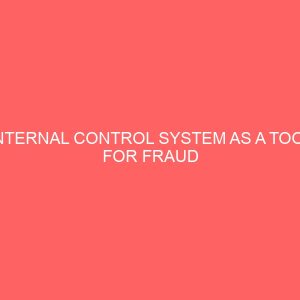Description
CHAPTER ONE: INTRODUCTION
1.1 BACKGROUND OF THE STUDY
An organization’s internal control system is comprised of the control environment, risk assessment, control procedures, monitoring, and information & communication system. It includes all the policies and procedures adopted by the directors and management of an entity to assist in achieving their objectives, ensuring, as far as practicable, the orderly and efficient conduct of their business, including adherence to internal policies, the safeguarding of assets, the prevention and detection of fraud and error, the accuracy and completeness of the accounting records, and the timely preparation of reliable financial information.
The control environment is an organization’s overall attitude toward controls. It is the tone at the top. Risk assessment is the process of identifying the risks faced by an organization. Once these risks have been identified then specific control procedures can be designed and implemented to address them. Monitoring is important to ensure that controls are functioning as designed. And Management uses an organization’s information and communication system to maintain the system of internal controls.
Every good system of internal control must be able to assist an organization carry on its business in an effective and efficient manner. It must be capable of sustaining credible adherence to management’s policies, safeguard its assets, and be able to guarantee complete recording of all its business transactions. A good system must exist to correlate responsibility with authority regarding the whole process of financial reporting and other spheres of the organization’s activity (Hamid, 2004:6).
Internal control systems must be effective, particularly in banking organizations where their stock-in-trade is cash. Ineffective internal control systems can results to high financial losses to banking organizations and their customers, the depletion of shareholders’ fund, as well as loss of confidence by the public. Similarly, fraud, which may result from ineffective internal control system, could in extreme cases lead to closure of banks as had happened in the country (Tanko, 2003:186). Owoh (2003:6) contends that weak internal control system renders an organization very soluble to fraud and corrupt practices. It encourages non-productive pursuits such as embezzlement, falsification of records and accounts, insider dealing, betrayal of fiduciary relationships, etc. The management of an organization has a duty to institute a system of internal control that will be appropriate to the enterprise. This will assist in preventing, or at least, substantially reducing the incidence, not only of mistakes, but also of irregularities and intentional errors, including fraud.
A system of effective controls is a critical component of a bank management and a foundation for safe and sound operation of banking organization. A system of strong internal controls can help to ensure that the goals and objectives of a banking organization will be met, that the bank will achieve long-term profitability targets, and maintain reliable financial and managerial reporting. Such a system can also help to ensure that the bank will comply with laws and regulations as well as policies, plans, internal rules and procedures, and decrease the risk of unexpected losses or damage to the bank’s reputation (Hamid, 2004:7).
This heightened interest in internal controls is, in part, a result of significant losses incurred by several banking organizations. An analysis of the problems related to these losses indicates that they could probably have been avoided had the banks maintained effective internal control systems. Such systems would have prevented or enabled earlier detection of the problems that led to the losses, thereby limiting damage to the banking organization (Hamid, 2004:6). Sound internal controls are therefore essential to the prudent operation of banks and to promoting stability in the financial system as a whole and ensuring corporate survival of banking organizations.
Internal control is a process effected by the board of directors, senior management and all levels of personnel. It is not solely a procedure or policy that is performed at a certain point in time, but rather it is continually operating at all levels within the bank. The board of directors and senior management are responsible for establishing the appropriate culture to facilitate an effective internal control process and for continuously monitoring its effectiveness: however, each individual within an organization must participate in the system. The exact application of internal control systems depends on the nature, complexity and risks of a bank’s operations. The main objective of internal control in banking organizations is to attain, operational, information and compliance objectives (Hamid, 2004:7).
Operational objectives of internal control pertain to the effectiveness and efficiency of the bank in using its assets and other resources in protecting the bank from loss. The internal control process seeks to ensure that personnel throughout the organization are working to achieve its objectives in a straight forward manner, without unintended or excessive cost or placing other interests (such as an employee’s, vendor’s or customer’s interest before those of the bank).
Information objective of internal control address the preparation of timely, reliable reports needed for decision making within the banking organization. They also address the need for reliable annual accounts, other financial statements and other financial related disclosures, including those for regulatory reporting and other external uses. The information received by management, the board of directors, shareholders and supervisors should be of sufficient quality and integrity that recipient can rely on it in making decisions.
Compliance objectives of internal control ensure that all banking business is conducted in compliance with applicable laws and regulations, supervisory requirements and internal policies and procedures. This objective must be met in order to protect the bank’s franchise and reputation, which are necessary for its survival.
In varying degrees, internal control is the responsibility of everyone in a bank. Almost all employees produce information used in the internal control system or take other actions needed to effect control. An essential element of a strong internal control system is the recognition by every employee of the need to carry out his responsibilities effectively and to communicate to the appropriate level of management any problems that may arise in operations, instances of non-compliance with the code of conduct, or other policy
violations or illegal actions that are noticed.
Many internal control failures that resulted in significant losses for banks could have been substantially lessened or even avoided if the board and senior management of organizations had established strong control culture. Adamu (2004:3) contends that good internal control is necessary in ensuring the healthy survival and growth of any organization especially financial institution. Internal control is being put in place to achieve accountability, prudence and completeness. One common feature of all strong banks in the country is their common passion for controls. They do not compromise on them (Adamu, 2004:3). Adamu (2004:3) reported that
available statistics has shown that all banks that have at one time or the other gone under have a weak internal control system in place. He argues that without weak internal control system there is no way that accounts could illegally be overdrawn, or be overdrawn with inadequate collaterals, or even be extended to a sector that is clearly under threat due to socio economic or other factors.
Banking is a dynamic, rapidly evolving industry. Banks must continually monitor and evaluate their internal control systems in light of changing internal and external conditions, and must enhance these systems as necessary to maintain their effectiveness and ensue their survival.
1.2STATEMENT OF THE PROBLEM
The prevalence of fraudulent practices in the Nigerian banking industry has affected the franchise and reputation of many banking organizations over the years. During the period, February 1951 and May 1952, 18 indigenous banks were registered. All of them failed without any exception within a short period. The failure of these indigenous banks was as a result of lack of banking expertise and non-prudent lending policies (Olalusi, 1997:145). History has it that by 1952, a total of 25 banks closed their doors to depositors in Nigeria with consequent untold hardship for customers. There is a story of a customer of Farmers’ Bank Limited who on finding that his bank had closed it doors indefinitely, suffered a heart attack and dropped dead by the bank premises (Abdullahi, 2002: 10).
Abdul Mutallab (2003:14) also reported that the operating licenses of thirty-six (36) banks were withdrawn between 1994 and March 2003, and many banks that were involved in foreign exchange malpractices were sanctioned. Abdullahi (2002:7) explained that in the year 2001, 723 cases of fraud and forgeries were reported in the Nigerian banking industry, out of which 388 were successfully executed representing 53.7%. The amount involved was N2.185 billion, while the actual loss totaled N1.07 billion, mainly through defalcation of customers’ cash lodgments by bank employees, substitution and depression of clearing cheques and manipulation of customers’ accounts. NDIC reported that the banking sector recorded N12.9 billion fraud-related cases in 2002/2003 financial year, and CBN was reported to have said that there were 981 reported cases of fraud and forgery involving N5 billion, $5.25 million and 1,701.17 million Pound sterling respectively in 2002 (The New Age, 2003:29). Out of this number however, CBN said 428 cases resulted in losses of N1.40 billion and $153,000 to the banks while the other cases were nipped in the bud.
NDIC reported in its 2002 annual report that 16 out of the 90 licenced banks in operation failed to insure the deposits kept in their banks in violation of section 32 of the NDIC Act. No. 22 of 1988 (as amended) as at December 2002. NDIC also stated in its 2002 annual report that the level of compliance with the requirement of fidelity insurance coverage by the 74 insured banks was 82.2% as against 90% in 2001(The New Age, 2003:29). CBN annual report for 2002 also indicated that the December 2002 deadline fixed for meeting the new minimum paid-up capital for existing banks of N1 billion has expired with only 39 banks representing 43% of the 90 licenced banks meeting the requirement (Abdullahi 2002:8). Pressures to deliver reasonable returns to shareholders has pushed some bank’s to take above normal risks, which has resulted in portfolio problems. Between 2001 and 2002, the Nigerian banking industry non-performing loans increased by 57% to N77 billion. Losses from fraud in the banking industry have remained high, and are likely to increase further as merchant banks converting to commercial banks have limited experience in commercial banking and are vulnerable to operational errors and frauds. These trends and the growth of unsound banks in 2002 were indeed worrisome and made many Nigerians to fear the survival of the industry.
Is it that the internal control measures put in place by banks in Nigeria are not effective or the role of managements in ensuring strict compliance to internal control system is below expectation? To what extent does in-effective Internal control systems threatens corporate survival in the Nigerian banking industry? Can corporate survival be ensured by good internal control system? What are the implications of non-compliance by banks with statutory regulations (CAMA’90, BOFIA’ 91, the Money Laundering Act of 1995, the Advance Fee Fraud & other fraud related offences Act 1995) and monetary circulars issued by the CBN on their internal control systems and corporate survival?
1.3 OBJECTIVES OF THE STUDY
One of the objectives of this research work is to determine the degree of relationship between ineffective internal controls system and fraud/forgeries of banks in Nigeria.
Another objective of the research work is to review the control environment in the Nigerian banking industry with a view to ascertain the overall attitude of the top-level management toward controls, the implications of such attitude on fraud/forgeries and performing and non-performing loans/advances, with a view to make recommendations that will bring about enhanced control and ensure survival of banks in Nigeria.
The research work equally intends to examine the relationship between internal control systems and corporate survival in the Nigerian banking industry and the extent to which internal control systems can make or mar corporate survival.
It is also an objective of this research to examine the implications of non-compliance by banks with laid down procedures and the extent to which such can affect corporate survival.
Lastly, the causes and implications of fraudulent and unethical practices, breach of procedures and legislations, and collapse of banks in the Nigerian banking industry, will be examined. The research also intends to make appropriate recommendations, in an attempt to make a modest contribution to knowledge.








Reviews
There are no reviews yet.